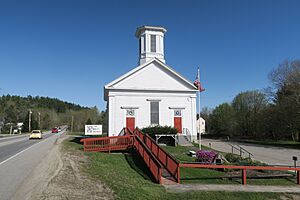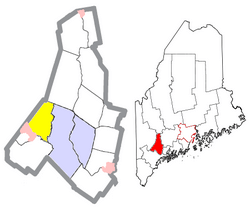Minot, Maine facts for kids
Quick facts for kids
Minot, Maine
|
|
|---|---|

United Methodist Church of Minot
|
|

Location of Minot (in yellow) in Androscoggin County and the state of Maine
|
|
| Country | United States |
| State | Maine |
| County | Androscoggin |
| Incorporated | 1802 |
| Villages | Minot Center Minot West Minot |
| Area | |
| • Total | 29.75 sq mi (77.05 km2) |
| • Land | 29.57 sq mi (76.59 km2) |
| • Water | 0.18 sq mi (0.47 km2) |
| Elevation | 669 ft (204 m) |
| Population
(2020)
|
|
| • Total | 2,766 |
| • Density | 93/sq mi (36.1/km2) |
| Time zone | UTC-5 (Eastern (EST)) |
| • Summer (DST) | UTC-4 (EDT) |
| ZIP Codes |
04258 (Minot)
04288 (West Minot) |
| Area code(s) | 207 |
| FIPS code | 23-46160 |
| GNIS feature ID | 0582599 |
Minot is a town located in Androscoggin County, Maine, in the United States. In 2020, about 2,766 people lived there. The town includes smaller areas called West Minot and Minot Center. Minot is part of the larger Lewiston-Auburn, Maine, area.
Contents
History of Minot
How Minot Began
The area that is now Minot was once part of a large piece of land called Bakerstown Plantation. A "plantation" was an early type of settlement. This land was given in 1765 to Captain Thomas Baker and his soldiers. They received it for their service in the 1690 Battle of Quebec.
In 1795, Bakerstown Plantation became an official town named Poland. It was named after Chief Poland, an important local Native American leader.
Minot Becomes Its Own Town
On February 18, 1802, the northeastern part of Poland separated and became the town of Minot. It was named after George Richards Minot (1758–1802). He was a historian and a judge who helped the town become official.
Early Settlers and Life
The first settler in Minot was Moses Emery, who arrived in 1772 from Newbury, Massachusetts. At that time, some Native Americans from the Anasagunticook tribe lived nearby. The land in Minot is hilly in some places, but it has good soil for farming. Farming was the main job for people living there in the early days.
Industries and Growth
People built mills along the rivers to use water power. These mills produced things like lumber, clapboards (wooden boards for houses), shingles, and barrels. They also made leather goods, such as boots, shoes, saddles, and harnesses.
Over the years, parts of Minot became new towns. In 1842, some land was used to create Auburn. More land was given to Auburn in 1873. In 1893, Mechanic Falls, an industrial village, also became its own town.
Minot Today
In 1859, Minot had 1,734 people. Today, Minot is slowly becoming a "bedroom community." This means many people who live in Minot travel to work in nearby cities like Auburn and Lewiston.
Geography of Minot
Minot covers about 29.75 square miles (77.05 square kilometers). Most of this area is land (29.57 square miles or 76.59 square kilometers). A small part is water (0.18 square miles or 0.47 square kilometers). The Little Androscoggin River flows through Minot.
Neighboring Towns
Several state roads cross through Minot, including Maine State Routes 11, 119, and 124. Minot shares its borders with these towns:
- Oxford and Hebron to the northwest
- Turner to the north
- Auburn to the east
- Poland to the south
- Mechanic Falls to the southwest
Population Changes
| Historical population | |||
|---|---|---|---|
| Census | Pop. | %± | |
| 1810 | 2,020 | — | |
| 1820 | 2,524 | 25.0% | |
| 1830 | 2,904 | 15.1% | |
| 1840 | 3,550 | 22.2% | |
| 1850 | 1,734 | −51.2% | |
| 1860 | 1,799 | 3.7% | |
| 1870 | 1,569 | −12.8% | |
| 1880 | 1,763 | 12.4% | |
| 1890 | 1,355 | −23.1% | |
| 1900 | 808 | −40.4% | |
| 1910 | 786 | −2.7% | |
| 1920 | 726 | −7.6% | |
| 1930 | 635 | −12.5% | |
| 1940 | 674 | 6.1% | |
| 1950 | 750 | 11.3% | |
| 1960 | 780 | 4.0% | |
| 1970 | 919 | 17.8% | |
| 1980 | 1,631 | 77.5% | |
| 1990 | 1,664 | 2.0% | |
| 2000 | 2,248 | 35.1% | |
| 2010 | 2,607 | 16.0% | |
| 2020 | 2,766 | 6.1% | |
| U.S. Decennial Census | |||
The population of Minot has changed a lot over the years. You can see how many people lived there in different census years in the chart above. In 2010, there were 2,607 people living in Minot. By 2020, the population had grown to 2,766 people.
Places to Visit
- Minot Historical Society & Museum: This is a place where you can learn about the history of Minot. It has old items and stories from the town's past.
Education in Minot
Minot is part of Regional School Unit #16. Kenneth Healey is currently the Acting Superintendent of Schools for the district.
The schools in this district include:
- Elm Street School
- Minot Consolidated School
- Poland Community School
- Whittier Middle School
- Poland Regional High School
Notable People from Minot
Many interesting people have come from Minot:
- William P. Bartlett: A politician who served in the Wisconsin State Assembly.
- Emma Bedelia Dunham (1826–1910): A talented poet.
- Ellen Hamlin: The wife of Hannibal Hamlin, who was the Vice President of the United States.
- Samuel G. Hilborn: A US congressman from California.
- William Ladd: He was the first president of the American Peace Society, an organization that promotes peace.
- Crosby Stuart Noyes: He owned and published a newspaper called the Washington Evening Star.
- Francis Slattery: A commander in the navy.
- Mesannie Wilkins: A 63-year-old farmer who became famous for traveling from Maine to California on horseback in 1954. She was known as the Last of the Saddle Tramps.
See also
 In Spanish: Minot (Maine) para niños
In Spanish: Minot (Maine) para niños


